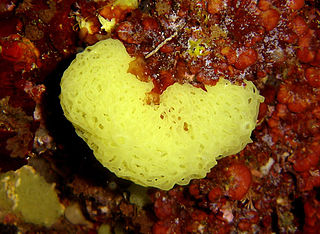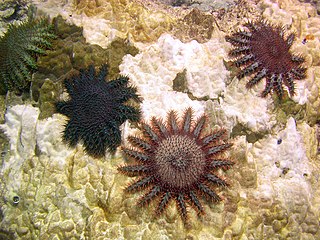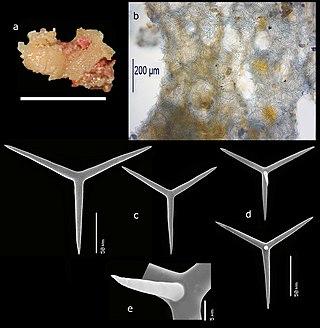
The hepatopancreas, digestive gland or midgut gland is an organ of the digestive tract of arthropods and molluscs. It provides the functions which in mammals are provided separately by the liver and pancreas, including the production of digestive enzymes, and absorption of digested food.

Thomson's gazelle is one of the best known species of gazelles. It is named after explorer Joseph Thomson and is sometimes referred to as a "tommie". It is considered by some to be a subspecies of the red-fronted gazelle and was formerly considered a member of the genus Gazella within the subgenus Eudorcas, before Eudorcas was elevated to genus status.

Clathrina is a genus of calcareous sponge in the family Clathrinidae. Several species formerly in Clathrina were transferred to the newly erected genera Arturia, Ernstia, Borojevia, and Brattegardia in 2013. The name is derived from the Latin word "clathratus" meaning "latticed".
Dendyidae is a family of calcareous sponges, which contains thirteen species in two genera.

Lamiinae, commonly called flat-faced longhorns, are a subfamily of the longhorn beetle family (Cerambycidae). The subfamily includes over 750 genera, rivaled in diversity within the family only by the subfamily Cerambycinae.

Elseya is a genus of large side-necked turtles, commonly known as Australian snapping turtles, in the family Chelidae. Species in the genus Elseya are found in river systems in northern and northeastern Australia and throughout the river systems of New Guinea. They are identified by the presence of alveolar ridges on the triturating surfaces of the mouth and the presence of a complex bridge strut.

Acanthaster is a bitypic genus of large and venomous starfish placed in its own family, Acanthasteridae. Its two members are known as crown-of-thorns starfish. Acanthaster are native to coral reefs in Indo-Pacific region.
Friedrich Joseph of Nauendorf, a general in Habsburg service during the French Revolutionary Wars, was noted for his intrepid and daring cavalry raids. Like most Austrian officers of the French Revolutionary Wars, he joined the military as a young man, and served in the War of Bavarian Succession. In the war's opening action, he successfully repelled a Prussian border raid, which earned him the admiration of the Empress Maria Theresa's son, Joseph. His continued success in the Habsburg border wars with the Ottoman Empire added to his reputation as a commander.

Arturia adusta is a species of sea sponge in the family Clathrinidae found in Australia. The species was first described as Clathrina adusta by Gert Wörheide & John Hooper in 1999, and was assigned to the genus, Arthuria, in 2016 by Oliver Voigt & Wörheide. However, the name Arthuria had already been used and hence the genus name was changed to Arturia.
Clathrina helveola is a species of calcareous sponge in the family Clathrinidae from Australia, found in coastal waters off Queensland. It was first described by Gert Wörheide and John Hooper in 1999. The species name, helveola, means "pale yellow" in Latin and refers to the species' colouration.
Clathrina heronensis is a species of calcareous sponge fin the family Clathrinidae and found in the seas around Australia, and in the coastal seas of many islands to her north. It was first described by Gert Wörheide and John Hooper in 1999.

Sycon is a genus of calcareous sponges belonging to the family Sycettidae. These sponges are small, growing up to 7.5 cm with a length from 2.5 to 7.5 cm, and are tube-shaped and often white to cream in colour. They are known to aquarium hobbyists as "Pineapple" or "Q-Tip" sponges, and are frequent "hitchhikers" accidentally brought in.

Soleneiscus is a genus of calcareous sponges in the family Dendyidae.
Sceptrulophora is an order of hexactinellid sponges. They are characterized by sceptrules, a type of microsclere with a single straight rod terminating at a bundle of spines or knobs. An anchor- or nail-shaped sceptrule is called a clavule. A fork-shaped sceptrule, ending at a few large tines, is called a scopule. A broom-shaped sceptrule, ending at many small bristles, is called a sarule.

Aspidoscopulia is a genus of glass sponge in the family Farreidae.
Gert Wörheide is a German marine biologist who works mainly on marine invertebrates. He earned his doctorate in geobiology from Georg-August-Universität, following this with a post-doctorate at Queensland Museum (1998-2002), where he worked with John Hooper on sponges, a collaboration which continues.
Platidiidae is a family of brachiopods belonging to the order Terebratulida.
Thecidellina is a genus of brachiopods belonging to the family Thecidellinidae.
Ospreyella is a genus of brachiopods belonging to the family Thecideidae.










